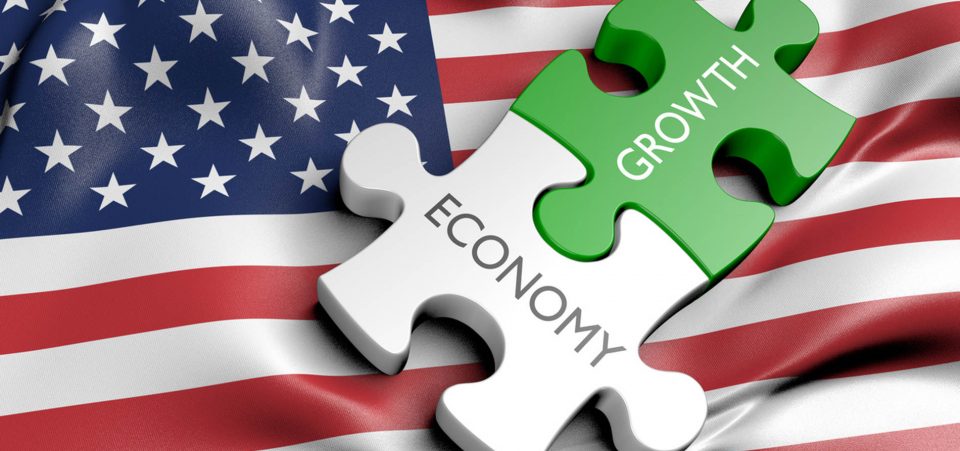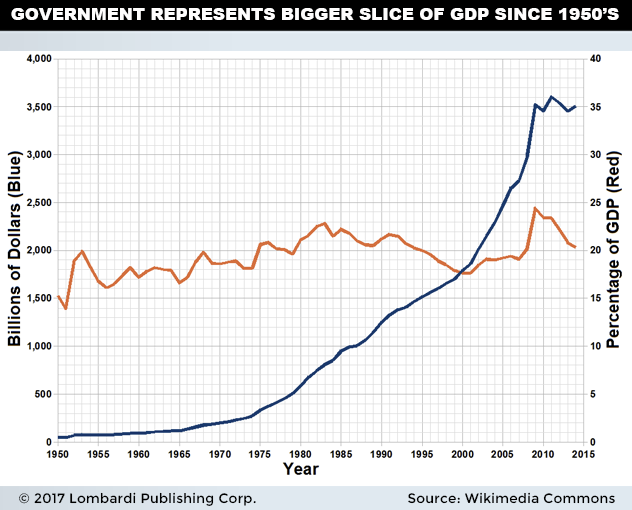Taxation Is the Major Obstacle to the U.S. Economic Growth Outlook
Savvy politicians know how to grab voters’ attention. They’re especially good at winning voters over with lists of benefits as appealing as a menu in a five-star restaurant. The part they miss is how to pay for those benefits. As anyone who’s ever visited a restaurant, even a one star restaurant, there’s always a bill to pay. That failure is what’s dragging the U.S. economic growth outlook for 2017.
What the politicians don’t dwell on is the independent variable of the “vote-for-me equals benefits-for-you” equation. The politicians simply assume that the rich will pay. They will tax the rich more to finance any increase in social spending. But they don’t ask: Does it really work? This curiosity oversight is what’s killing the U.S. economy.
There’s no need to rely on opinions in that regard. It’s a fact that since the 1950s, U.S. government spending as a percentage of gross domestic product (GDP) has almost doubled, as the chart below shows.
In the 1950s, federal government spending represented 15% of GDP. In the 1960s, not even the Vietnam War, the Cold War, and the hugely expensive Space Program sent GDP rocketing beyond the 20% mark. Meanwhile, over the last few years, government spending has reached just about a quarter of GDP. These are conservative estimates.
Some suggest U.S. government spending as a percentage of GDP has reached almost 40%. In fiscal 2017, the U.S. Office of Management and Budget suggests total government spending (Federal, State, and Local) will amount to 36%. Government healthcare and pensions account for the biggest portions of the spending. Together, they account for 16% of the total. (Source: “US Total Government Spending Breakdown,” usgovernmentspending.com, last accessed March 13, 2017.)
Americans’ taxes are the source for all those trillions. The problem is that an overwhelming amount of those taxes comes from a single group. Credible statistics suggest only 55% of all Americans are paying federal income taxes. That means that 45% are not. That’s a staggering amount by any standard. (Source: “New Estimates Of How Many Households Pay No Federal Income Tax,” Forbes, October 6, 2015.)
Of the 55% of income taxes that the federal government collects, you can bet that a disproportionate chunk comes from America’s biggest earners. How does this hurt the U.S. economy? This is not an exclusively American problem. But it is a problem to which America, given its nature, has become highly sensitive.
Simply put, income taxes destroy economic incentives. They also destroy job creation. All that money that high-income owners pay in taxes could have otherwise been directed to investments in enterprise, stimulating innovation and jobs. More jobs are a far better income distributor than taxes will ever be.
Those who receive benefits from taxes would have received even greater benefits by earning more money directly. Or, they would simply keep more of their earnings. The reality is that the U.S. government, along with most government purporting to be beacons of free enterprise and innovation, has adopted one or more models of socialism.
Governments effectively asphyxiate growth; they act as a drought on cultivable land. Taxes end up producing a vicious circle if left unchecked. Nobody is arguing for the elimination of taxes altogether. Governments establish a link to the population through taxes. Without them, there would be no stakes and no interest for members of that government to perform.
Thus, excessive taxation stifles the most important driver of welfare for all citizens: economic growth. Economic growth results from one or both of these things: increased consumption and investment. The math is simple. If a person has two dollars in their pocket and four in the bank; they would be more willing to part with the sum in their pockets.
That’s the true essence of disposable income. When people are more confident about their purchasing power—that is, disposable income—they feel more encouraged to invest as well. Governments, in their seemingly infinite capacity and willingness to tax more, have forgotten an essential principle.
It’s a principle that happens to be woven into the very fabric of the American Dream; people are the true engine of economic growth. Disposable income can be considered the fuel for that engine. Confident consumers, secure about their ability to save, create wealth through their dual actions of spending and investing.
The way the U.S. government has been taxing its citizens lately, you might be forgiven for thinking this concept has been lost. Perhaps members of Congress did not get the memo that advised the fact the Tooth Fairy does not exist. Governments have focused too much on the latest economics and econometric trends instead of good old-fashioned common sense.
Thus, Trump has the right idea. He wants to lower taxes. The problem is that he also wants to increase spending. The formula is correct and falls in line with the basic points cited above. The way taxation has been applied as a solution is killing capitalism and the economic outlook. Thus, if politicians and governments want to stimulate economic growth, there’s one thing they must do before all others.
They should take a step back. All governments proclaim economic growth to be their main goal. Yet, no matter how loud the fanfare around that promise is, they inevitably cut disposable income and investment through taxation. Moreover, governments inefficiently spend those dollars outside the market, avoiding any need for competitiveness.
Moreover, while the government spends millions of its taxpayers’ dollars, thousands of companies struggle to keep up with taxes. Inevitably, hundreds of thousands of Americans lose or will lose their jobs as a result. And the vicious cycle continues. Instead of leaving businesses in a position to keep (or hire more) employees, they are forced to downsize.
But, in this version of a dog chasing its tail, the government also pays for its shortsightedness. By forcing companies to shut down, or seek cheaper pastures abroad, and laying off employees, they reduce the amount of taxes they take in. Taxes make American companies less competitive. They are less equipped to compete on the world market.
Lately, the trade deficit has sometimes been blamed on the higher value of the U.S. dollar. That’s certainly a factor, but not the only or even the most important one. The dollar merely magnifies the effect of higher personal and business taxes compared to many international competitors.
Taxation reduces private consumption and investment. The trade-off is that the public sector becomes bloated. Many taxes are needed to fulfill salary obligations in the civil service, one government expenditure that could certainly use a diet. Perhaps President Trump should postpone the infrastructure spending program.
His priority should be to persuade the government to pass a package to free up and simplify the economy. Congress, which will have a Republican majority for the next two years, should focus on increasing gross domestic product by encouraging more private sector investment.
There can be little doubt that the biggest barrier to GDP growth is the current confiscatory taxation regime. This is not merely the opinion of this author or some conservative House Representatives and Senators or pundits on TV. Many economists have confronted the problem over the years.
The Armey Curve and the Inverse Relationship Between Growth and Taxation
One of the best concepts to illustrate the problem of income taxes and their unwholesome effect on economic outlook is the Armey curve. The curve, illustrated below, identifies the inverse U-shaped curve that exists between tax rates and tax revenues. The notion was borrowed from the Laffer Curve. (Source: “Laffer Curve,” Investopedia, last accessed March 14, 2017.)
A lesser-known concept is that of the Armey curve, named by Republican senator Richard Armey, who first popularized it in the debate on the effects of public spending. The Armey curve correlates public spending and GDP growth. Like the Laffer Curve, it has an inverted U shape.
Now, it should be stressed that not all taxes are bad. There is a reasonable amount of taxation that helps business and contributes to GDP growth. The Armey curve makes it abundantly clear. Indeed, without even low levels of public spending, the State cannot ensure respect for private contracts. Nor can it protect property rights. Without these basic assurances, there can be no real GDP growth.
There are some government-financed activities that even a libertarian like Senator Ron Paul would concur with. These include the protection of property rights and the enforcement of private contracts. Of course, where would the military and the defense of national U.S. territory be without taxes?
The state of law is fundamental to economic growth. Thus, taxation is needed to ensure that the institutions that exist to protect citizens from themselves exist. But, there is a flip-side. With high levels of public spending, and therefore intense taxation, the people—Americans—have no incentives to invest and produce.
Exorbitant taxation kills economic growth. The Armey curve elegantly shows that when public spending is high, GDP growth suffers. There is an optimal level of public spending that can maximize gross domestic product. Taxation distorts economic mechanisms and reduces efficiency.
Now, the United States is facing a situation such that because government spending has ballooned, so have taxes gone out of control. The current high tax burden on incomes lifts incentives for capital accumulation. Accumulated capital is the main source of investment. There are other less obvious sources of taxpayers’ funds: subsidies.
Subsidies are as anti-capitalist and free market a mechanism as there can be. They are an essential by-product of excessive taxation and economic misguidance. Governments, under pressure from lobbies, hand over generous subsidies to companies in mature industries, where research and development have long gone the way of the dodo.
Subsidies, drain government—taxpayers’—resources from more productive enterprises to distribute them to businesses that, in many cases, should be already out of business. This becomes a self-perpetuating problem, because subsidies encourage the mushrooming of the very type of businesses that benefit from subsidies.
Instead, subsidies, if acceptable, would trigger more GDP growth mechanisms if they were directed toward new and productive sectors that need incubation in new sectors. Subsidies also promote legalized corruption. Politicians promise of subsidies in exchange for votes, finding ever new ways to waste taxpayers’ resources.
In such a system, the least deserving members of the economic community end up getting the resources. In a more market-oriented mechanism, such inefficiencies would be easier to avoid.








